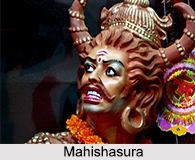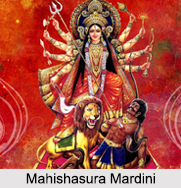 In Hindu mythology, the story of Mahishasura is an important symbolism filled legend, particularly Shaktism. Mahishasura was a king with the head of a buffalo, whose symbolical representation presents forces of ignorance and chaos hidden by outer appearances. The symbolism is carried in Hindu arts found in South Asia and southeast Asia known as the Javanese artwork. Here, the Goddess Durga is shown as a serene, calm, collected and graceful symbol of good as she pierces the heart and kills the scared, overwhelmed and outwitted Mahishasura The legendary battle of Mahishasura as evil and Goddess Durga as good is narrated in many parts of South Asian and Southeast Asian Hindu temples, monuments and texts such as the Devi Mahatmya. The slaying of Mahishasura was a prominent theme which was sculpted in various caves and temples across India. Some of the prominent representations are seen at the Mahishasuramardini caves in Mahabalipuram, the Ellora caves, in the entrance of Rani ki vav, the Hoysaleswara Temple in Halebidu and many more temples across India.
In Hindu mythology, the story of Mahishasura is an important symbolism filled legend, particularly Shaktism. Mahishasura was a king with the head of a buffalo, whose symbolical representation presents forces of ignorance and chaos hidden by outer appearances. The symbolism is carried in Hindu arts found in South Asia and southeast Asia known as the Javanese artwork. Here, the Goddess Durga is shown as a serene, calm, collected and graceful symbol of good as she pierces the heart and kills the scared, overwhelmed and outwitted Mahishasura The legendary battle of Mahishasura as evil and Goddess Durga as good is narrated in many parts of South Asian and Southeast Asian Hindu temples, monuments and texts such as the Devi Mahatmya. The slaying of Mahishasura was a prominent theme which was sculpted in various caves and temples across India. Some of the prominent representations are seen at the Mahishasuramardini caves in Mahabalipuram, the Ellora caves, in the entrance of Rani ki vav, the Hoysaleswara Temple in Halebidu and many more temples across India.
Origin of Mahishasura
According to the Upapuranas, there was once an asura called Rambhasura, who performed several sacrifices in order to please Lord Shiva and beget a son. Appeased with his efforts, Lord Shiva granted Rambhasura his boon of having a son, who would be invincible and renowned in all the three realms. Shiva fulfilled his wish by incarnating him as Rambhasura"s son and thus Mahishasura was born, son to an asura father and a buffalo mother. Mahishasura was the buffalo incarnation of Lord Shiva. He grew up to be a strong asura, an ace warrior, a wise scholar and under his rule, the asuras thrived.
 Mahishasura was a staunch worshipper of Lord Brahma. After years of penance, Brahma was finally pleased and offered him a wish. Driven by power, Mahishasura demanded immortality. His wish was that he should not be killed by any "man or animal" on the face of Earth. Brahma granted him this wish, and then told him that a woman will be the end of him. But filled with arrogance, Mahishasura believed women to be weak, fragile and inferior to him and thus he thought that there was no woman in the world who could cause him any harm.
Mahishasura was a staunch worshipper of Lord Brahma. After years of penance, Brahma was finally pleased and offered him a wish. Driven by power, Mahishasura demanded immortality. His wish was that he should not be killed by any "man or animal" on the face of Earth. Brahma granted him this wish, and then told him that a woman will be the end of him. But filled with arrogance, Mahishasura believed women to be weak, fragile and inferior to him and thus he thought that there was no woman in the world who could cause him any harm.
Various Concepts of Annihilati on of Mahishasura
The legend continues, after Lord Brahma granted Mahishasura the boon of immortality, he was high on power and attacked the Trilok : the three worlds of heaven, hell and earth. He even went far as to capture Indralok, which is the kingdom of Lord Indra. Mahishashur waged war against the Gods but due to Lord Brahma`s boon nobody was able to defeat him. The Gods thus approached Lord Vishnu for help. After much consideration, the holy trinity: Lord Brahma, Lord Vishnu and Lord Shiva decided to together combine all their powers and create a female form to defeat Mahishasura. Thus, came forth Goddess Durga, who is an incarnation of Goddess Parvati, the daughter of Himavan, the lord of the mountains. She is the mother-goddess also known as Shakti, which is the power that runs the universe. Goddess Durga then fought Mahishasura over a period of 15 days during which he kept changing his shape to become different animals and misled her. Finally when he transformed into a buffalo, Goddess Durga stabbed him with her trident and that was the end of him. Mahishasura was defeated and killed on the day of Mahalaya. This story is widely narrated during Durga Puja.
Another version of the legend states that Mahishasur had worshipped 16 armed Bhadrakali after he saw a dream in which the same Devi had slain him. Appeased, the Goddess appeared before Mahishasur and he told her that through that dream he had realized that his end was near. Hence, he asked the Devi to provide him moksha after uplifting him by slaying. The Devi blessed him and told that after she will free him of his mortal coil, he will never reincarnate on earth and will merge into her. Devi even made Mahishasur aware that this was his third birth as an Asura. In the previous Kalpas, she had slain him in the form of Ugrachanda and Bhadrakali. In his dream, he had seen the very same Bhadrakali who had slain him in previous Kalpa. Thus, Devi said that in her Mahishasur Mardini form, Mahishasur will always remain below her left foot and be worthy of worship whenever her worship would be performed. As we know that Mahishasur was actually a form of Shiva himself who had taken birth to free Lord Vishnu of half the weight of Devi he had to bear in the form of lion, her vehicle. Thus, the Devi keeps her left foot on Mahishasur, and right foot on lion, who is a form of Shri Hari. Hence, these are some of the myths behind Mahishasur"s end by Goddess Durga.
In another tale, the legend of Mahishasura dates back to almost 3000 years when Mahishasura was a non-Aryan king whose people worshipped the buffalo. Mahishasura`s power knew no bounds as he defeated many Aryan kings in the northern kingdom of Aryabarta. While many kings were defeated by Mahishasura, a queen came to rule the northern part of Aryabarta. The kings who were already defeated by the mighty king pledged their allegiance to the Queen. Her army grew in strength and numbers, while Mahishasura was running out of supplies and man power. Thinking that he could not be defeated by a woman, he sent out messengers to the queen to become his consort. The queen kept refusing but Mahishasura was not to back off easily and continued insisting her by sending more messengers. Meanwhile, the queen planned an attack on the buffalo king when Mahishasura`s army was too worn out to protect themselves from the queen`s army. Mahishasura himself thought that he could defeat the queen but she killed him with her spear, tore his chest and fed him to his pet lion.
Having its roots in various legends and being a part of the Hindu mythology, the concept and origin of the Mahishasura has been discussed in myriad texts and scriptures over the years.









